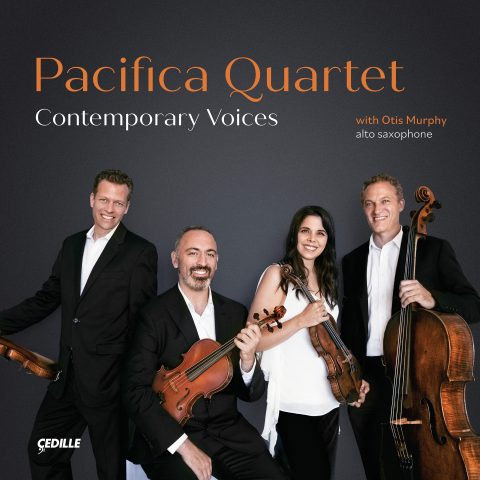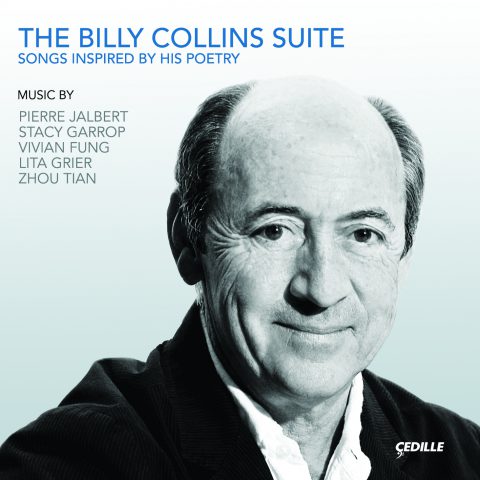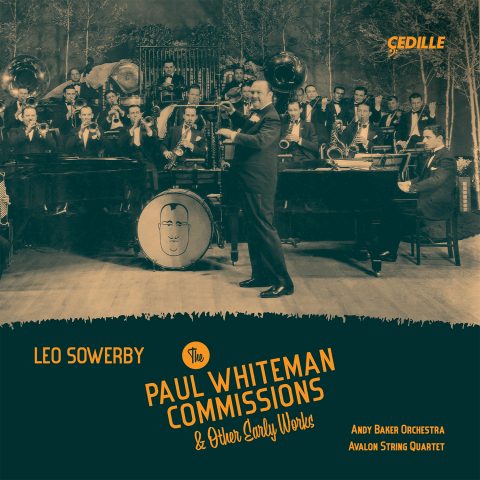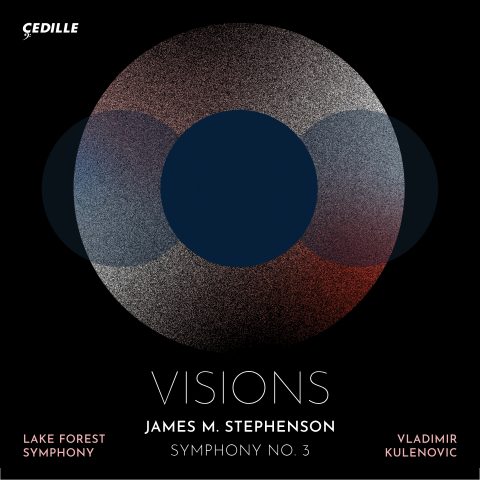| Subtotal | $18.00 |
|---|---|
| Tax | $1.85 |
| Total | $19.85 |
Store

Saxophonist Julian Velasco headlines an inventive, virtuosic, and diverse album of contemporary classical works for soprano, alto, and tenor sax as winner of Cedille Records’ first Emerging Artist Competition, a juried event celebrating the independent classical label’s 30th anniversary of championing Windy City artists of world-class talent.
For his first-ever album as a featured soloist, Velasco has assembled a program he says reflects “the different musical aspects of my life at this moment” while paying tribute to “the unique and wonderful people with whom I have been lucky enough to surround myself.”
As We Are opens with works for saxophone and piano, performed with collaborative pianist extraordinaire Winston Choi. These include the world-premiere recording of classical saxophonist and composer Steven Banks’ Come As You Are, with Velasco on tenor sax, a composition influenced by African American sacred music and structured like a four-movement sonata. Velasco picks up his alto sax for David Maslanka’s Tone Studies No. 5: Wie bist du, Seele, which adopts its melody from a J. S. Bach four-part chorale. John Anthony Lennon’s Distances Within Me explores the vocal qualities of the alto sax in a score drawing inspiration from early 20th-century avant-gardist Alban Berg’s Wozzeck and jazz fusion bands like pianist Chick Corea’s Return to Forever. Amanda Harberg’s Court Dances, heard here in the world-premiere recording of the soprano sax version, is a three-movement suite referencing French Renaissance and Baroque court dances.
Works for saxophone and electronics include world premieres of the soprano sax versions of Elijah Daniel Smith’s Animus and Christopher Cerrone’s Liminal Highway. Animus places the live-in-studio saxophonist “in conversation” with his own recordings. Liminal Highway, inspired by a John K. Sampson poem of the same name, calls for extended techniques such as flutter-tongue, slap-tongue, and key clicks, while enlisting a harmonica and empty beer bottles, also played by the saxophonist.
Preview Excerpts
Steven Banks (b.1993)
Come As You Are
David Maslanka (1943-2017)
John Anthony Lennon (b. 1950)
Distances Within Me
Amanda Harberg (b. 1973)
Court Dances
Elijah Daniel Smith (b. 1995)
Christopher Cerrone (b. 1984)
Liminal Highway
Artists
Program Notes
Download Album BookletAs We Are
Notes by Julian Velasco and the composers
For several years, I have wanted to write a piece dedicated to my immediate family (my mother and three sisters) and the influence of my upbringing on my understanding of music and life in general. It seemed obvious to me that this piece needed to take influence from African-American church music in some way. In an effort to honor both my family and the church, I decided to write a four-movement work in which each movement would be dedicated to a different family member and take inspiration from their favorite Negro spiritual or sacred song. My mother chose “I Still Have Joy.” My three sisters, Kharma, Jennifer, and Ashley, chose “His Eye is On the Sparrow,” “My Lord, What a Morning,” and “Wade in the Water,” respectively.
At its core, Come As You Are is an expanded arrangement, or setting, of these four songs. As a more direct reference to the music played in the church that I grew up going to, the song “Total Praise,” which is typically sung by a choir, serves as a sort of connective tissue throughout the entire piece. The titles of each movement come from lyrics of “Total Praise.” The text of each song is vital to understanding the expressive nature of each movement.
When interpreted through the lens of classical music, these movements are configured in a way that is intended to align with a slightly deviant four movement sonata form that composers such as Schumann, Rachmaninoff, Shostakovich, and many others used in several of their works. In this form, the first movement is an allegro, the second a scherzo or dance, the third an adagio, and the last movement is another fast one, perhaps with a dance feel or including a theme and variations.
Through the lens of African-American sacred music, the first two movements, “Lift My Eyes” and “Times of the Storm,” are inspired by traditional Negro spirituals. It is important to note that spirituals often contained text that was Biblical on the surface, yet deeply personal or communicative in intention. “My Lord, What A Morning” and “Wade in the Water” are no exceptions to this tradition.
In this spirit, I aimed to strike a balance between the surface-level meaning of these spirituals and what they might have meant for the people who sang them. There may seem to be striking dichotomies in character that are reflective of these varied meanings. The last two movements, “Strength of My Life” and “Lift My Hands,” are inspired by songs that are more common in religious practices today. In these, I have tried to make a musical depiction of the lyrics in a way that conveys the message of each song from my perspective.
In many ways, I have experienced all of these aspects of myself finally beginning
to merge. As a composer, I strive to let my internal musical voice be “ok” and to follow it where it wanders, trusting that this amalgamation of experiences is leading me in a direction that is uniquely mine and informed by my various interests and identities.
—STEVEN BANKS, Come As You Are (MARCH 2020)
TONE STUDIES NO. 5: WIE BIST DU, SEELE? | David Maslanka
Wie bist du, Seele (Soul, how have you become so unhappy?) is the fifth study from Tone Studies, a set of six pieces that are, for the most part, slow and quiet.
David remarked of the work:
“I chose the title Tone Studies because each movement, and in fact each moment, offers a large number of choices about quality of sound, choices that will evolve with deepening study . . . [and] continue to unfold over time. Each study is a small and passionate essay — a “short story” without words. The original melodies can all be found in the 371 Four-Part Chorales by J.S. Bach. The key for both the pianist and saxophonist is patience — patience with tempi, patience with fermatas, patient and careful listening into tones produced by each instrument and by the two together. This music asks and requires that you listen deeply. When you do, a special settled heart energy arises.”
Tone Studies was commissioned by Joseph and Janet Lulloff for their son, Jordan.
DISTANCES WITHIN ME | John Anthony Lennon
In 1974, I was in Bill Bolcom’s composition seminar at the University of Michigan when he and Donald Sinta gathered the saxophone studio together with the composition students to try out ideas for saxophones, from soprano to bass. That day the Michigan Saxophone Quartet was there: James Forger, Lynn Klock, Steven Mauk, and Clifford Leaman. They demonstrated their instruments and answered our questions. Among the composers were Stephen Chatman, Edmond Cionek, and Arthur Gottschalk. Soon after this, I wrote a piece for the School of Music orchestra with an alto part that was performed by Jim Forger. The sound of the instrument and its vocal quality rang in my ears. In 1978, Jim asked me to compose a piece for the N.A.S.A. saxophone conference at Northwestern University. I worked on this new piece that became Distances Within Me.
At the time, I was absorbed by the music of Alban Berg, particularly Wozzeck, and by popular groups like Return to Forever. These were some of the sounds in my ear at the time.
I wrote Distances in Knoxville, where I moved to teach at the University of Tennessee. In those days before computers with music programs, the score was written at the piano and transcribed with ink onto transparent ozalid paper. Copying, as laborious as it was, became part of the creative process that began with listening to the instrument and asking questions about how it worked.
—JOHN ANTHONY LENNON (MAY 2022)
COURT DANCES | Amanda Harberg
Court Dances was initially inspired by the fast, syncopated bounce of a squash ball and grew into a celebratory three movement suite referencing 16th and 17th century court dances. The first movement, Courante, reflects the lively character and triple meter typical of its Baroque namesake. The lyrical and flowing Air de Cour offers introspective contrast to the more gregarious outer movements. The dynamic final movement, Tambourin, references both the eponymous Provençal dance and French drum through its accents, syncopation, and percussive effects. Court Dances was commissioned in 2017 by flutist Cobus du Toit as a consortium project supported by 57 co-commissioners from around the world. A few years later, saxophonist Julian Velasco had the idea of making a soprano saxophone version of the work. I collaborated with Velasco during the early days of the Covid-19 pandemic to create the new arrangement. This is the world premiere recording of Court Dances for soprano saxophone and piano.
—AMANDA HARBERG (MAY 2022)
ANIMUS | Elijah Daniel Smith
Animus aims to create a composite instrument from the live solo line and “tape.” The soloist is in conversation with themself and their own recordings, creating an atmosphere that is simultaneously one player and an indistinct number of players through a hazy veneer.
—ELIJAH DANIEL SMITH (MAY 2022)
LIMINAL HIGHWAY | Christopher Cerrone
Liminal Highway was originally conceived as a work for flute and electronics on a commission from Tim Munro. Inspired by a poem of the same name by the poet and songwriter John K. Samson, the five-movement work sought to explode the idea of a traditional flute solo by incorporating new techniques such as key clicks, multiphonics, air sounds, and pre-recorded and live electronic processing. The work premiered in 2016. A few years later, I began adapting Liminal Highway for the saxophone. Many saxophonists had approached me about a new work; I thought that many of the percussive sounds employed in Liminal would naturally lend themselves to the instrument.
Around this time, I ran into Julian Velasco at a performance at the Bang on a Can Summer Festival at Mass MoCA. We got to chatting and he mentioned how much he liked Tim’s performance of Liminal Highway, so I broached the idea of a sax version; the rest is history. The translation of the work was quite smooth, although some challenges, like a stratospherically-high piccolo, required some creative solutions.
The work is cast in five movements, each one mirroring a line in Samson’s poem. The first, “When you fall asleep in transit,” is focused on layers of flutter-tongue (playing the instrument while rolling the tongue). It is played both on the soprano sax and also the harmonica — the solution to the above-mentioned piccolo issue. The second, “A dream you don’t recall,” features the rhythmic and insistent
clicking of keys before layers of slap-tongue, air, and overblown sax take over.
The third, “Between consciousness and sleep” alternates a stabbing high note against a bed of quiet multiphonics (using the “wrong fingering” to get two notes at the same time). The fourth, “Liminal,” mirrors the second movement. And the fifth and final, “Suddenly it is needed,” reprises the harmonica and another found object — discarded beer bottles, which are also played with the same flutter-tongue technique.
Liminal Highway was commissioned by New Music USA and Miller Theatre at Columbia University for Tim Munro. The version for saxophone was made in
collaboration with Julian Velasco.
—CHRISTOPHER CERRONE (MAY 2022)
Notes by
Album Details
ALBUM PRODUCER
James Ginsburg
PRODUCERS
James Ginsburg (works with piano), Christopher Cerrone (Liminal Highway), Mike Tierney (Animus, Liminal Highway)
ENGINEERS
Bill Maylone (works with piano), Mike Tierney (Animus, Liminal Highway)
RECORDED
March 15–16 2022, Galvin Recital Hall, Evanston, IL (works with piano)
April 12–13, May 3rd and 5th 2022, Shiny Things Studio, New York, NY (Animus, Liminal Highway)
GRAPHIC DESIGN
Madeleine Richter
COVER PHOTO
Jaclyn Simpson
PUBLISHERS
Come As You Are © 2020 Steven Banks Tone Studies
No. 5: Wie bist du, Seele © 2010 David Maslanka
Distances Within Me © 1981 Dorn Publications, Inc.
Court Dances © 2018 Theodore Presser Company
Animus © 2018 Elijah Daniel Smith (soprano saxophone version © 2020)
Liminal Highway © 2016 Christopher Cerrone, Outburst-Inburst Musics (ASCAP).
All rights administered exclusively by European American Music Distributors LLC.
CDR 90000 213



